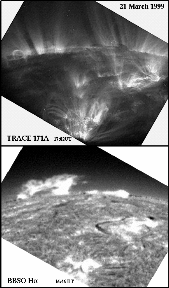 |
These images (taken on 21 March 1999) compare
the corona (as seen by TRACE in the 171Å passband; 1 million degrees) and the
chromosphere (as seen at Big Bear Solar Observatory in the hydrogen alpha line;
some 10,000 degrees).
The cool filaments/prominences show up as bright off the disk in hydrogen alpha,
but as dark, absorbing features in the extreme ultraviolet image at the top.
 |
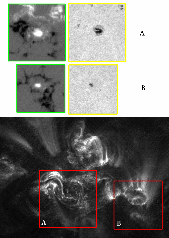 |
This composite of observations was taken on 10 February 2000, at about
01:35UT. The lower image is part of a TRACE 171Å image, showing plasma
at 1 million degrees. The red box ``B'' shows a so-called anemony field
geometry, in which a pore (shown in the magnetogram in the green box, and in
white light in the yellow box) of one polarity is surrounded by field of
opposite polarity. In the case of the sunspot in box ``A'', however, the
sunspot carries so much electric current that the field lines circle around
it before entering its penumbra, not being able to simple dive into it in
what should have otherwise been at least a partial anemone.
 |
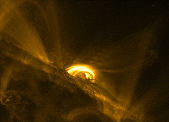 |
|
This solar X-class
flare was observed by TRACE at 16:43UT on 22 November 1998, in the
171Å passband (characteristic of 1-million degree gas; in gold, on the
left), 1600Å UV passband
(characteristic of thousands to hundred thousand degrees; in red on the
right), and in the
white-light passband (mostly visible light; in pale yellow in the right).
The flare heats up an arcade
of loops at the edge of the disk that light up in the extreme ultraviolet.
They quickly cool down, and the material rains out of them. That the cooler
material is seen in the 1600Å image is not unusual, but that it is dense
enough to be seen even in the white-light channel next to the very bright
solar disk makes this a rare event. The event was pointed out by
Harry Warren (SAO, Cambridge, MA), who wrote a paper on this event to
be published in Letters to the editor of the Astrophysical Journal.
|
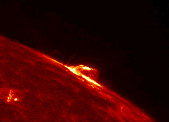
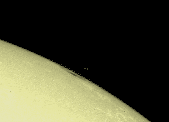 |
 |
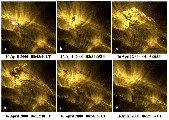 |
Filament destabilization observed
with TRACE, in the 171Å passband (1 million degree emission) on 16 April 2000.
A small
active-region filament near the arrow in panel a begins to destabilize
at 03:43 UT; at this time it is still cool (some 10,000 degrees) and dark
as it absorbs any coronal emission coming from behind it. The filament rises
(with an average velocity close to 70 km/sec, or 250,000 km/hour),
and material in it heats up to coronal temperatures (panel b).
Then, within about 8 minutes (panel c),
the filament shows its connections to distant fields, much of
the material heats up, and material moves along the nearly horizontal
field towards the lower-right in the images (which have all been rotated
over +90 degrees for clarity). It only takes a few minutes for much of
the material to cool down again to some 10,000 degrees, so that it absorbs
much of the emission from behind it (panel d). It then begins to drain from
the high loops, falling down towards the surface, mostly at the original
filament site, but some of it slides down towards the distant footpoint
(panel e). After approximately 2 hours, all seems to have
returned to the original state.
Larger version of the individual images:
a,
b,
c,
d,
e,
f. Each panel shows
440x440 pixels, of 375 km each.
 |
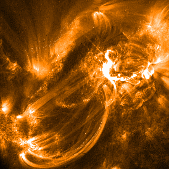 |
|
This solar flare was observed by TRACE at 03:30UT on 12 April 2000, in the
171Å passband, characteristic of 1-million degree gas. The image on the left
was taken shortly after the flare started. It shows the primary flare site just
right from the center. Very fast beams of energetic particles traveled along the
field lines toward the left, which upon impact on the lower, cooler atmosphere
light up along a curved track. That track is more easily seen on the right. This
is the difference between the image at 03:33:22UT and at 03:31:51UT. Where it is
white, the image brightened; where it is dark, it became dimmer. It shows that
the flare site is connected to a dome of field lines, ending along the ridge on the
left; this dome is presumably a separatrix, that is, a surface that separates
field lines that connect to different magnetic concentrations on the solar
surface. The difference image also shows that loops are distorted by the flare. The
so-called moss, the footpoints of loops that are too hot to see in this image, have
moved about rapidly in the short time interval, causing the black-and-white
reticulated pattern at various locations in the image. Click
here to view
the difference image without annotation.
|
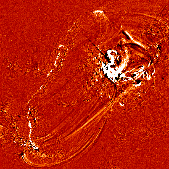 |
 |
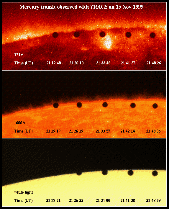 |
A collage of images taken with the
Transition Region and Coronal
Explorer. The images are taken in the 171-Angstrom channel (Fe IX/X;
characteristic of material at approximately 1 million degrees),
the 1600-Angstrom passband (UV line and continuum emission; mostly
showing material at around 5500 degrees on the disk, and material at
about 100,000 degrees just above the solar limb), and a
broad-band white-light channel (around5500 degrees). Note that whereas
the planet Mercury just comes within the edge of the Sun in white light,
it comes much further onto what appears as the disk in the extreme
ultraviolet (EUV) image at the top: the offset between the white-light
and EUV limbs is approximately 4,000 (plus or minus 200) km. This
is caused by the envelope of chromospheric material immediately above the
surface: white light goes right through is, but EUV light does not. The
EUV doesn't shine through until much higher. This demonstrates clearly
that the Sun is just a gaseous sphere without a well defined surface:
at different wavelengths the Sun has a different size.
 |
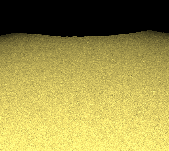 |
This TRACE image taken in visible light
shows the start of the solar eclipse of 11 August 1999 (image taken
at 09:09:13 UT). The moon is just beginning to cover the Sun, starting
at the north pole (an effect of the TRACE orbit over the Earth's
terminator). The image is sharp enough to see the mountains on the
edge of the moon, and the small (1,000 km) convective cells on the
solar surface, called granulation. Note also the darkening of
the solar disk toward the edge.
 |
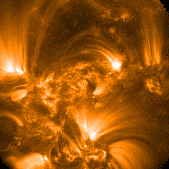 |
|
The image on the left is a 171Å image taken by TRACE on 4 April 2000, at
13:10UT, showing plasma at approximately 1 million degrees.
The image shows Active Region 8939 near the central meridian; the field
of view is 290,000 (800 TRACE pixels) to a side. The image on the right
shows the ratio of the 191A to 171Å images, displayed logarithmically,
ranging over a factor of three up and down from unity. That images shows the
temperature of the emitting gas; the coolest material is shown in red,
warmer in green, and the hottest in blue. The brightly emitting fans of
coronal loops emanating from strong concentrations of magnetic field on the
surface are coolest, getting somewhat warmer with height. The warmest plasma
is found over the patches of ``moss'' in the 171Å image. This ``moss'' is
formed by the lower parts of loops that have temperatures of 3 to 5
million degrees. The moss is the layer between that hot material and the
much cooler chromosphere below. The diagonal ripples in the outer parts of the
temperature image are an instrumental effect, also seen weakly in the 171Å
on the left. Click on either image to view the pair side by side. Click
here, and
here to view
the full-sized images separately.
|
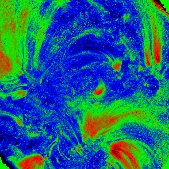 |
 |
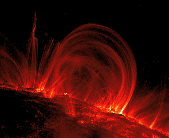 |
|
This image (with another color table on the right)
of coronal loops over the eastern
limb of the Sun was taken in the
TRACE 171Å pass band, characteristic of plasma at 1 MK, on November 6, 1999,
at 02:30 UT. The image was rotated over +90 degrees.
This image was also the
Astronomy Picture of
the Day for 28 September 2000. |
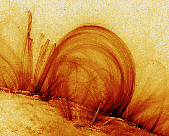 |
 |
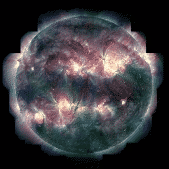 |
The solar corona as observed by the Transition Region and Coronal
Explorer (Handy et al., Solar Physics Vol. 187, p. 229;
Schrijver et al., Solar Physics Vol. 187, 261)
on 29 June 1999 around 02 UT. This mosaic is made up of 3 exposures
at each of 23 pointings. The green, blue, and red color tables in this
``true color'' image represent the 171 A (1 MK), 195 A (1.5 MK),
and 284 A (2 MK) channels, respectively.
The image was prepared by J. Covington
(Lockheed-Martin Missiles and Space, Palo Alto).
 |























